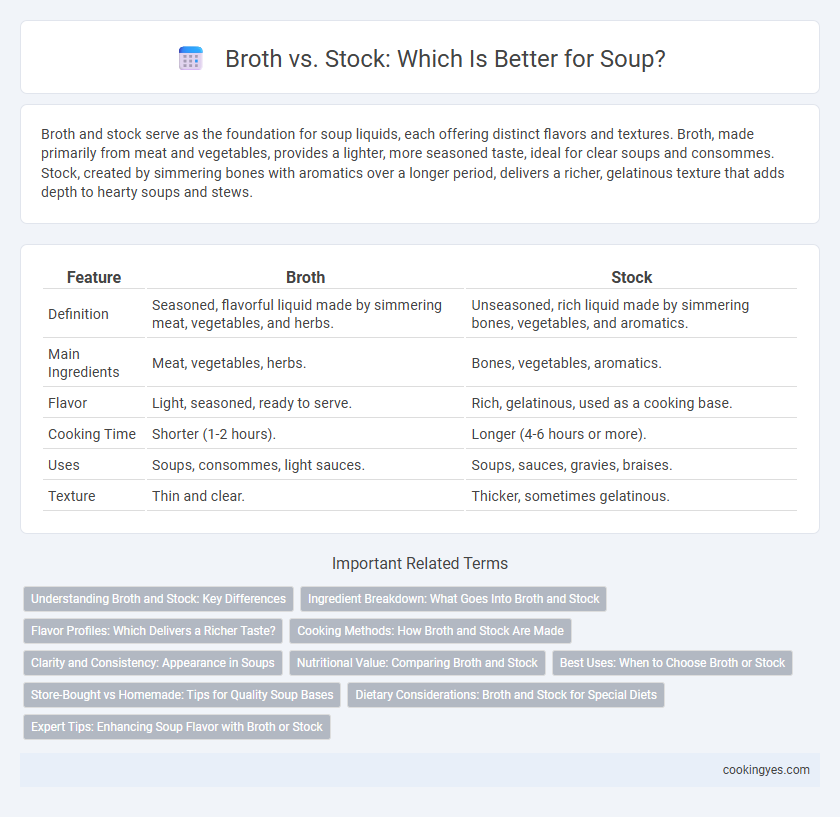Broth and stock serve as the foundation for soup liquids, each offering distinct flavors and textures. Broth, made primarily from meat and vegetables, provides a lighter, more seasoned taste, ideal for clear soups and consommes. Stock, created by simmering bones with aromatics over a longer period, delivers a richer, gelatinous texture that adds depth to hearty soups and stews.
Table of Comparison
| Feature | Broth | Stock |
|---|---|---|
| Definition | Seasoned, flavorful liquid made by simmering meat, vegetables, and herbs. | Unseasoned, rich liquid made by simmering bones, vegetables, and aromatics. |
| Main Ingredients | Meat, vegetables, herbs. | Bones, vegetables, aromatics. |
| Flavor | Light, seasoned, ready to serve. | Rich, gelatinous, used as a cooking base. |
| Cooking Time | Shorter (1-2 hours). | Longer (4-6 hours or more). |
| Uses | Soups, consommes, light sauces. | Soups, sauces, gravies, braises. |
| Texture | Thin and clear. | Thicker, sometimes gelatinous. |
Understanding Broth and Stock: Key Differences
Broth is a flavorful liquid made by simmering meat, vegetables, and aromatics, typically lighter and seasoned for direct consumption. Stock is a rich, gelatinous liquid created by simmering bones, connective tissues, and vegetables, offering a deeper body and used as a base for soups and sauces. The key difference lies in broth's focus on pronounced flavor and clarity versus stock's emphasis on texture and mouthfeel from collagen extraction.
Ingredient Breakdown: What Goes Into Broth and Stock
Broth is typically made by simmering meat, vegetables, and aromatic herbs, resulting in a lighter, flavorful liquid that often includes salt. Stock is primarily prepared by simmering bones, connective tissues, and vegetables for an extended period, extracting collagen and minerals to create a richer, gelatinous texture. The key ingredient difference lies in broth's emphasis on meat and seasoning versus stock's focus on bones and long cooking for depth and body.
Flavor Profiles: Which Delivers a Richer Taste?
Broth offers a lighter, clearer flavor derived primarily from meat and vegetables simmered briefly, creating a delicate taste ideal for soups requiring subtlety. Stock, cooked longer with bones, connective tissues, and vegetables, extracts gelatin and minerals that result in a richer, fuller-bodied flavor ideal for hearty soups and sauces. The collagen released from bones in stock enhances mouthfeel and depth, making it the superior choice for delivering a robust flavor profile in soups.
Cooking Methods: How Broth and Stock Are Made
Broth is made by simmering meat, vegetables, and seasonings in water for a shorter time, resulting in a lighter, clearer liquid with delicate flavors. Stock involves simmering bones, often roasted, along with mirepoix and aromatics for several hours to extract gelatin, creating a richer, thicker texture. The difference in cooking time and ingredients significantly affects the body and taste of the final soup liquid.
Clarity and Consistency: Appearance in Soups
Broth offers a clearer and lighter appearance in soups due to its strained nature and use of meat and vegetables, resulting in a more transparent liquid. Stock, made primarily from bones and connective tissue, yields a richer, more gelatinous consistency with a slightly opaque or cloudy look, enhancing mouthfeel and body. Choosing broth or stock depends on desired soup clarity and texture, with broth preferred for clarity and stock for a thicker, more robust consistency.
Nutritional Value: Comparing Broth and Stock
Broth contains more sodium and fewer nutrients due to shorter cooking times and use of meat and vegetables, making it lighter but less nutrient-dense. Stock is rich in collagen, gelatin, and minerals extracted from bones through long simmering, providing higher nutritional value and beneficial amino acids. Both serve as flavorful soup bases, but stock offers superior nourishment for bone and joint health.
Best Uses: When to Choose Broth or Stock
Broth, made from simmered meat and vegetables, offers a lighter flavor ideal for clear soups and quick cooking dishes like ramen or consomme. Stock, rich in collagen from bones, provides a thicker, more gelatinous texture perfect for hearty stews, sauces, and slow-cooked soups that benefit from depth and body. Choose broth for a delicate, savory base and stock for robust, nutrient-dense cooking foundations.
Store-Bought vs Homemade: Tips for Quality Soup Bases
Homemade stock offers richer flavor and higher nutrient content than most store-bought broths, which often contain added sodium and preservatives. For quality soup bases, opt for homemade stocks simmered with bones, vegetables, and herbs, ensuring a deeper, more complex taste. When using store-bought broth, choose low-sodium varieties and enhance them with fresh aromatics to improve flavor without compromising convenience.
Dietary Considerations: Broth and Stock for Special Diets
Broth is typically clearer and lighter, making it suitable for low-fat, low-sodium diets, while stock, simmered longer with bones, offers higher collagen and mineral content ideal for bone health and joint support. People following paleo or keto diets often prefer bone broth for its nutrient density and protein content, whereas broth fits well in vegan or low-calorie diets when derived from vegetables. Sodium levels in store-bought broth can be high, so homemade or low-sodium options are recommended for heart-healthy eating plans.
Expert Tips: Enhancing Soup Flavor with Broth or Stock
Using stock as a soup liquid imparts a rich, deep flavor due to its long simmering of bones and aromatics, which releases gelatin and minerals enhancing mouthfeel. Broth offers a lighter, clearer taste ideal for delicate soups or when a subtler base is desired, often made primarily from meat and vegetables. Expert chefs recommend adjusting seasoning and choosing between broth or stock based on the desired soup intensity and texture to maximize flavor complexity.
Broth vs Stock for soup liquid Infographic

 cookingyes.com
cookingyes.com